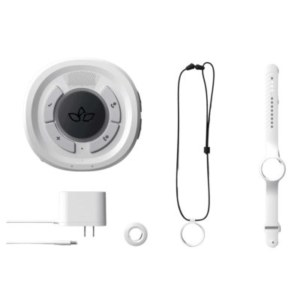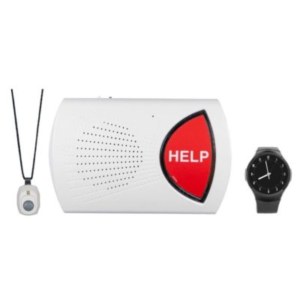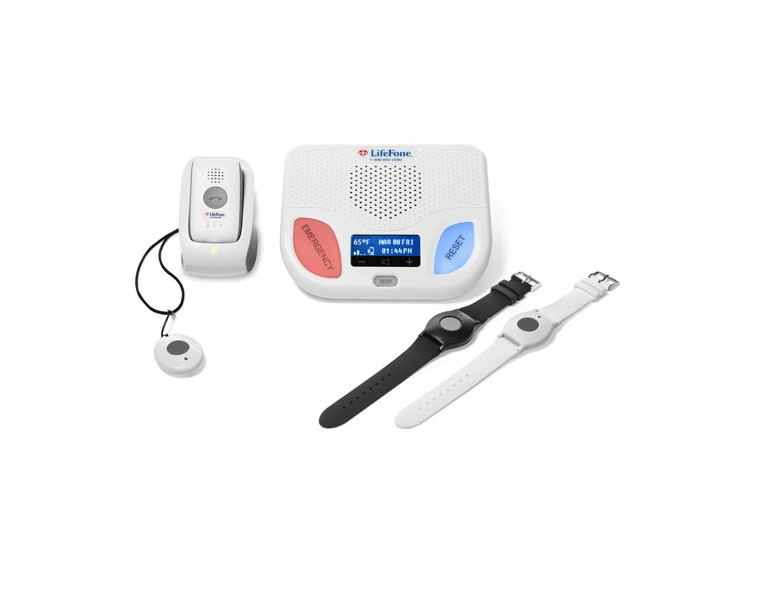Best In-Home Medical Alert Systems
Falls are the leading cause of injury-related death among people aged 65 and older according to the Centers for Disease Control and Prevention (CDC). Many falls that happen in the home become deadly because help cannot be reached. If you take a fall and can’t get to a phone, pain and panic–or worse–can result. This scary scenario can be eliminated by installing an in-home medical alert system.
The best in-home medical alert systems feature base stations and wearable help buttons that provide access to emergency call centers 24/7, 365 days a year. Many also provide easy access to family members and emergency contacts, such as nearby neighbors. In addition to falls, these life-saving devices can be used for any type of emergency, including:
- Fire
- Break-ins
- Heart attack
- Stroke
- Confused thinking
- Panic attacks
Key Takeaways
- In-home medical alert systems can run through landlines or cellular connections.
- Medical alert systems have wearable help buttons that connect you with emergency call centers 24/7.
- You can use your in-home medical alert system for any type of emergency, including fires and break-ins.
Overview: What Are In-Home Medical Alert Systems?
In-home medical alert systems run through telephone landlines or cellular networks. Most systems don’t require professional installation or technological know-how to operate. Many simply need to be plugged into an electrical outlet. Landline-based systems require a phone jack.
In-home medical alert systems are connected to professional call centers that operate around the clock. In the event of an emergency, you contact the call center by pressing a help button on a wearable device or base station. Some systems are voice activated and don’t require you to press a button. You can also choose a system that has automatic fall detection. These systems use sensors in order to contact the call center automatically when they detect a fall.
In-home medical alert systems do not have GPS location tracking. If you drive or spend a good amount of time in outdoor locations, a mobile system or bundled system may be best for you. Bundled systems include in-home and on-the-go protection. Mobile systems are designed to be used outside of the home.
No medical alert system is completely foolproof. Even the best in-home system has risks and limitations, such as:
- Automatic fall detection may not detect every fall that occurs.
- Medical alert systems don’t take the place of one-on-one contact and shouldn’t be used as a “babysitter.”
- It’s important to test your system regularly to make sure the battery isn’t depleted.
- User compliance is also necessary.
Best In-Home Medical Alert Systems
- Best automatic fall detection: Aloe Care Health Total Care
- Best wall mount buttons: Bay Alarm Medical In-Home Premium Alert System
- Best lifetime warranty: LifeFone At-Home Medical Alert System
Best In-Home Medical Alert Systems Reviews
Products
- One-time equipment cost: $349.99
- Monthly cost: $49.99
- 30-day money-back guarantee
Aloe Care Health is a relative newcomer to the field of medical alert systems and was founded in 2018. The brand´s at-home systems are technologically advanced and intuitive to use. They’re appropriate for people who aren’t tech savvy, as well as those who are comfortable with navigating the latest technology.
Aloe Care Health Total Care
Aloe Care Health’s Total Care at-home system easily made our Best In-Home Medical Alert Systems review. We especially liked the voice-activated Smart Fall Sensor that can sense when falls occur without needing to be physically worn. Also impressive, this system’s average response time is under 30 seconds.
This system includes:
- 24/7 emergency response
- Smart Hub base station with backup battery (only lasts four to six hours)
- Aloe Care Health App for your Care Circle contacts
- Mobile Companion with automatic fall detection for indoor and on-the-go protection
- Wearable help button and wristband
- Smart Fall Sensor with voice recognition for the bathroom
- Two wall-mounted motion sensors that detect unusual activity in the home
Aloe Care Health’s base system is called the Smart Hub. The Hub has amplified clarity for the hard of hearing. To reach help through the Hub, you press a large button on the device, or say the word “emergency” three times from anywhere in the room where the Hub is located. The Hub is voice activated and doesn’t require Wi-Fi to work.
You can make and receive calls through the Hub from anyone listed in your Care Circle. The Smart Hub lets you hold conversations with family members or with Aloe Care’s Five Diamond Emergency Response Center from anywhere in the room. The Smart Hub also has built-in motion, temperature, and air quality sensors that detect VOCs (volatile organic compounds) and CO2 (carbon dioxide) in the home.
The Aloe Care Health app lets you create a Care Circle with an unlimited number of contacts. Circle members can use the app to call the Smart Hub. They can also use it to connect with each other via group chat to best coordinate your care. The app and Smart Hub communicate with each other so that your contacts are kept in the loop about your movements at home. If an emergency occurs, your contacts will be given full information via the app.
Since many falls at home happen in the bathroom, the Smart Fall Sensor is recommended for bathroom use. You can, however, place it wherever you feel it will be most beneficial for you. Once the sensor is installed, it can recognize that someone is sitting, standing, or lying on the floor. Unlike the Hub, the Smart Fall Sensor requires Wi-Fi.
- Equipment cost: $0
- Monthly Cost: $39.95
- Automatic fall detection: $10 per month
- 30-day trial period
Bay Alarm Medical is a well-established medical alert system company that has a great track record with consumers. The brand´s parent company, Bay Alarm, has manufactured trusted security systems for over 75 years.
Bay Alarm Medical In-Home Premium Medical Alert System
The In-Home Premium System requires a cellular connection and runs on the AT&T 4G cellular network. If you prefer to run your system through a landline, Bay Alarm Medical has a less expensive in-home option you can choose instead. The features that set Bay Alarm’s In-Home Premium system apart from the brand´s other systems are the four wall-mounted help buttons included in the package. If you don’t like the feel of a wearable device, this system may be a great choice for you.
This system includes:
- 24/7 emergency access
- Base station with 32-hour backup battery
- Help button and lanyard or wristband
- Four wall mounted help buttons
- Medical account manager app
Bay Alarm Medical’s call center, based in the United States, can accommodate users in over 170 languages. According to the company, its response time to emergency calls is 45 seconds or less.
The wearable help button can be popped into a necklace or wristband. It has a range of 1,000 feet, which is significantly larger than other wearables. Help buttons without automatic fall detection have a battery life of around five years. Help buttons with automatic fall detection have a battery life of around two years.
- Equipment cost: $0
- Monthly Cost: $29.95 for the landline system, $34.95 for the cellular system
- Automatic fall detection: $5 per month
- 30-day money-back guarantee
- 100% lifetime warranty
LifeFone is an established medical alert system company that has been in operation since 1976. The brand has a 4.6 out of 5-star rating on Trustpilot. One of the features that sets LifeFone apart is its 100% lifetime warranty on equipment and free equipment replacement.
LifeFone At-Home Landline Or Cellular Medical Alert System
LifeFone’s at-home medical alert unit is available as a cellular or landline-operated system. You don’t need cellular service in order to operate the cellular system. It is run through LifeFone’s AT&T cellular network.
Both the landline and cellular units have optional fall detection, a 32-hour backup battery, and a 1,300-foot range.
The in-home system includes:
- 24/7 emergency access
- Base station
- Help button with your choice of wristband or lanyard
- Room temperature sensor
When you set up your LifeFone device, you create personalized emergency care instructions that are based on your personal preferences and needs. This provides information that the emergency response call center will use when you contact them. For example, you can request that a family member or doctor be contacted before 911, provided you’re not having a medical emergency that requires an ambulance. You can also request that 911 always be contacted as soon as you activate the help button.
Other Medical Alert Systems That Didn’t Make the List
There are many at home medical alert systems that provide excellent products. Even though they didn’t make the list of our top three, you may also want to check out our review for the following companies:
How to Choose the Best In-Home Medical Alert System That’s Right for You
The best in-home medical alert system for you may be different from the one that’s best for your neighbor or friend. Features to consider include:
Cost: Find out if the system is free or if you have to pay for the equipment. There may be differences in monthly fees based upon whether you pay for the whole year up front, quarterly, or monthly. Always check to see if cancellation fees apply. Some systems have free shipping, but others don’t.
Range: The size of your home and the number of floors you have matter. Base station ranges can vary significantly. Find out what your home’s square footage is before you choose a system. If you have access to a backyard or outdoor area, it is important to include that footage in your calculations.
Languages spoken: Most emergency call centers are based in the U.S. and employ English speakers. If your native tongue is another language, find out if the call center has real-time translation services available. Even if you speak English, you may be most comfortable speaking in your native tongue during an emergency.
Response time: Medical alert systems must provide quick response times. However, these response times will vary between companies. Always ask what the average response time is for your location before you choose a system. Response times may also vary based on whether you have cellular or landline service. Keep all of these factors in mind when you ask about response times.
User compliance: To get the fullest protection from your system, you should wear a help button. If you don’t like the look or feel of a help button, choose a system that includes a smartwatch or pendant that disguises your device. Using an in-home system with wall mount buttons is also a good idea.
Caregiver tools: Some systems include an abundance of options for keeping caregivers in the loop. Others are lacking in this area. If connecting with family or nearby emergency contacts is important to you, look for a system that has caregiver tools in place, such as a care circle app.
Features To Consider When Shopping for an In-Home Medical Alert System

- 24/7 Emergency Response. Always double check that the system you choose provides 24/7 emergency response, 365 days a year. Emergencies don’t take holidays off, so neither should your emergency response system.
- Equipment fees. Equipment fees vary from $0 to several hundred dollars. If you want a mobile device, such as a smartwatch, you may pay the highest equipment fee. Be sure to check what the fee is for your system, and also find out if there is a lease or buy option.
- Monthly rates. Monthly rates vary as well. You may get the best deal if you pay for a full year upfront. If you decide to go this route of paying upfront, find out if you can get your money back if you no longer need your system.
- Two-way talk. Some systems only have two-way talk capability from the base station. Others have two-way communication available from the help button.
- Caregiver apps. Caregiver apps provide a variety of features, including group chat options, billing and payment information, and battery status. Apps can also be used by you or the emergency response team to send out texts or emails to your contacts.
- Quick response time. Response times vary between companies, but they are usually always under one minute. Some companies offer response times as fast as 20 seconds or less.
- Water resistance. Wearable help buttons may be water resistant or waterproof. It’s very important that you can wear your button in the shower, even if you have a wall mounted help button in the bathroom. If you prefer baths to showers, always opt for a completely waterproof option versus a water-resistant button.
- Fall detection. Fall detection is usually available as an option for help buttons that are worn around the neck. This feature is especially important to have if you live in a house with stairs, slippery flooring, or area rugs. It is also important if you have a condition that makes you prone to falling, such as epilepsy or diabetes.
MORE ADVICE
How Do Medical Alert Systems Work?How Do Medical Alert Systems Work? Learn more about the technological assistive device helping seniors maintain their independence.Read More
Summary
In-home medical alert systems can save your life in an emergency. They can be used for medical and non-medical emergencies. The best in-home medical alert systems feature a fast response time and caregiver tools, and also offer an easy setup. Automatic fall detection is an important feature for most people. It is usually available as an add-on for an additional monthly fee.
Why You Can Trust Us
To make our choices for this “Best Of” list, we reviewed the in-home medical alert systems offered by most of the leading companies operating in the U.S. today. We only chose systems that get very positive user reviews for response times and customer service. We analyzed manufacturers´ claims, and only chose products that come from transparent companies with good track records. We also kept cost and special features in mind, as well as safety and speed.
Frequently Asked Questions
-
Most in-home medical alert systems don’t require a Wi-Fi connection but do require either a landline or cellular connection. One system on our list uses Wi-Fi specifically for a wall sensor that detects falls in the room.
Other Medical Alert Guides And Medical Alert Systems That We Have Reviewed
- Best Medical Alert Systems
- Best Medical Alert Systems with Fall Detection
- Best Personal Emergency Response Systems (PERS)
- Best Medical Alert Systems With No Monthly Fee
- Best Medical Alert Watches for 2022
- Best Medical Alert Bracelets for Seniors
- Best Medical Alert Systems with GPS
- Medical Guardian Review
- Aloe Care Health Review
- MobileHelp Review
- Bay Alarm Medical Review
- Medical Alert Review
- GreatCall Review
- LifeStation Review
- LifeFone Review
- Philips Lifeline Review
- MobileHelp Smart Review
- Alert1 Review
- ADT Medical Alert Review
- Apple Watch Medical Alert Review
- GreatCall Lively Mobile Reviews
- Rescue Alert Medical Alert Review
- Life Alert Review
Learn More About Medical Alert Systems
WRITTEN BY
Corey Whelan is a writer, health care professional, and Brooklyn, New York native. She is a reproductive health advocate who has helped countless patients through the trials and triumphs of infertility and adoption over the past 25 years. Corey's passion is sharing her knowledge of health and wellness through her writing, and no topic is off limits. She's mom to two grown children and two rescue dogs who captured her heart.







